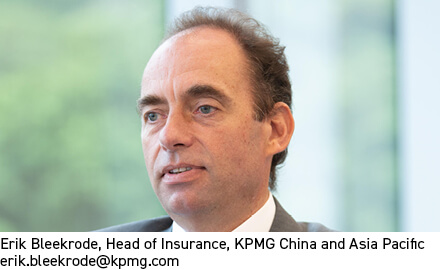KPMG: Why 2021 is a pivotal year for IFRS 17 preparations the world over
November 11 2020
By Erik Bleekrode, Head of Insurance, KPMG China and Asia Pacific
“After the extension of the implementation date for IFRS 17, the year 2021 will be absolutely critical for insurers to ensure that they are ready to go live in 2023,” Erik Bleekrode, KPMG
The deferral of the effective date of the new accounting standard IFRS 17 to 1 January 2023 has given insurers some breathing room to prepare for the transition, but for all there is still an enormous amount of work to do and the year ahead will be a very big year for the entire industry.
Many of the large insurers have already invested a significant amount of time, effort and resources into preparing for the transition since the International Accounting Standards Board issued the first version of the final standard in May 2017. However, there has been some loss of momentum in 2020 due to the deferral of the standard’s implementation date, as well as the disruption caused by Covid-19. Some organisations have revisited their strategy and recalibrated their budgets, others have further deferred starting the implementation process in earnest.
With the finish line now firmly in sight and the clock ticking, 2021 will be a critical year for organisations to stay on course for a controlled IFRS 17 transition.
Some of the key focus areas for 2021
Organisations will need to finish building their IFRS 17 systems and ensure that they undergo rigorous testing from end to end. For the international insurers, a key task as part of this will revolve around an effective roll out to all countries.
Then there is the transition of projects to BAU – business as usual — which involves the design of the right target operating model, processes and controls as well as a discussion on where the opening balance sheet gets calculated. It requires a handover of responsibility at the right time. As part of that process, all BAU teams need to be properly trained up to be able to deliver IFRS 17 numbers and be able to understand them.
When it comes to understanding the numbers, an important question is how to visualise the IFRS 17 results and how to ensure that you can drill down into its details. As dry runs and parallel runs increase in frequency, it will become ever more important to be able to do this quickly, so this visualisation needs to happen through the right tool – and many IFRS 17 solutions do not come with this functionality.
In addition, once organisations start to produce and understand their numbers, they should translate this into management information, key performance indicators, and planning and forecasting processes. Apart from compliance reporting, finance functions need to deliver on this aspect as well in order to drive value for the business and embed IFRS 17 in the basics of financial steering.
Finally, there is a big strategic question around how and when to start communicating around initial outcomes of the IFRS 17 transition with both internal and external stakeholders.
As it stands, we have observed that only a few organisations have reached the stage where they are producing bottom up results at scale, and many have not yet started work on the topics outlined above. All of this just goes to show how much work still lies ahead.
It’s all about people
The number of activities that need to be conducted in 2021 will place significant pressure on project teams, many of whom have been in project mode for two to three years already. And with the smaller companies that are sometimes only at the early stages of their projects, insurers need to consider and manage the risk of employee attrition. People may suffer from project fatigue in their current role or, as projects get closer to the finish line, they may become uncertain about their role and career opportunities within their own organisation. It is up to employers to retain the intellectual capital they have built over time and make sure that they offer a clear career path to their talent.
Collaboration is key
With all the delivery pressures on 2021, everyone can be assured that there will also be surprises. Things that are delayed, results that are unclear, expectation gaps between group and countries, interpretations that change and things that have fallen between the cracks. It is essential to address these challenges with a collaborative mindset, with understanding and appreciation for everything that has gone well, and an attitude of working as a team to clear them one by one and work towards the finish line.
In summary, 2021 will be a defining year and a difficult one. The ability of organisations to stay the course and meet their objectives in 2021 will determine how effectively they can work on parallel numbers in 2022, practice to be able to report within the working day timetable and go live in 2023 with confidence. The organisations that get this right will end up with a finance function which is stronger, more motivated and better prepared for its role as a business partner. They will then be able to provide real value to the business, help them understand the drivers of results in a new world and equip them to make better business decisions.

The views and opinions expressed herein are those of author and do not necessarily represent the views and opinions of KPMG Asia Pacific.
-
QBE | Elevating customer experience, humanising claims: QBE Asia’s ‘Solutions in a Box’
Vastly improving turnaround times and personalising service delivery, QBE Asia’s award-winning, end-to-end bundled claims solutions is a game-changer for the insurance industry.
-
Beazley | What does cyber protection look like from day 1 to day 600 and beyond?
Cybersecurity is no longer just an IT concern, but a governance issue that belongs on the boardroom agenda.
-
Sedgwick | Preparing for the next storm
Insurance industry needs to recalibrate, invest in innovation and strengthen systems, talent and data practices.
-
Peak Re | From climate modelling to market opportunity: Forging a new clarity on Southeast Asia’s climate risk
Southeast Asia's protection gap: a crisis of clarity, not just capital
